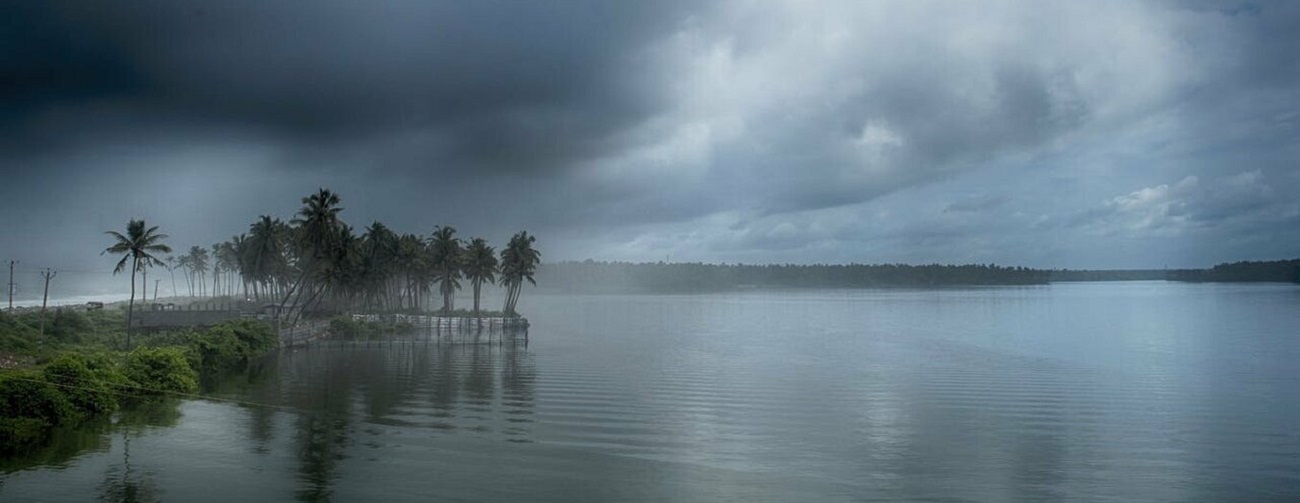Photo: Monsoon clouds approach in India | Source: Manoj Felix/Shutterstock
Monsoons – The Lifeline of the Indian Subcontinent
India is a country that lies mainly in the tropical zone, due to which its climate is mainly warm. It is also the only country in the world which is cradled by the magnificent Himalayas in the north, and three bodies of water around the peninsula: The Indian Ocean, Bay of Bengal, and Arabian Sea. These geographical traits make India one of the most unique countries of the Indian Subcontinent. Many of these geographical features enable us to experience the torrential rains that we know and love, every year. Monsoons are considered the life-force of India, as we are endowed with the largest water-bearing cloud system in the world. Therefore, the climate of India may also be broadly described as tropical monsoon type.
Monsoons play a pivotal role in the agrarian economy of India since over three-fourths of the total rain in the country is received during the southwest monsoon season. Apart from agriculture, it is also important for the survival of our natural ecosystem, and for the collection of water for daily use. Industries in India also rely on the much awaited monsoons since a great deal of electricity in the region is produced by hydroelectric power plants, which are driven by the copious amounts of water collected during the monsoons.
Each year, the monsoon literally transforms life in India. In the wild, lush green landscapes cloak the environment. Rejuvenated lakes and streams lead to rapidly flowing rivers and heavy waterfalls. The biodiversity is so rich and full of life, it’s the ideal escape from the mundanity of city life.
Indic culture has been illuminated by the literature, art, architecture, music, and dance surrounding the joys and gifts associated with the Monsoons. Even today, this season remains the scintillating theme of India’s economy, religion, culture and art. This blog will take you on a journey from the traditional and cultural importance, all the way till the geographical and meteorological significance of this season in India.
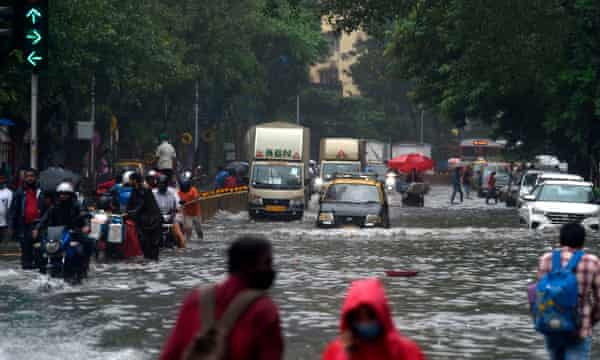
1 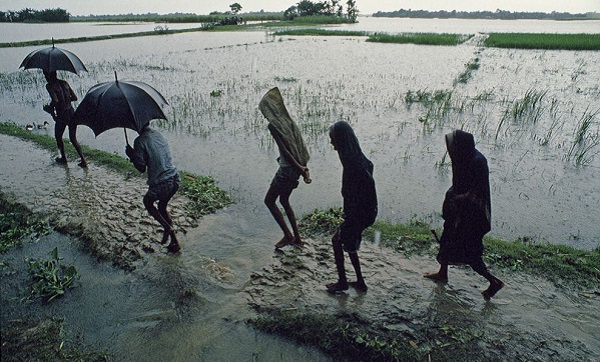
2 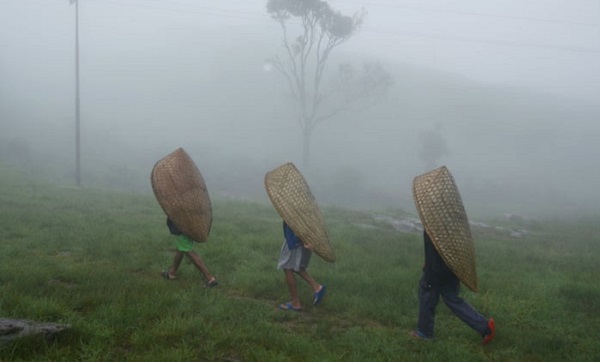
3
Photo 1: Mumbai has wettest monsoon season in more than 61 years | India | The Guardian
Photo 2: Monsoon in India | National Geographic Society
Photo 3: Mawsynram in Khasi Hills of Meghalaya, India’s North-East state- the wettest place on Earth | The Guardian
History and Significance of Monsoon In India
The history & significance of the monsoon are discussed here to understand the meaning of monsoon clouds, how it is depicted in all of our literature and song, Nakshatra based monsoon rainfall climatology and it’s influences on agriculture, monsoon- ‘Varsha Ritu’ as per the Hindu Calendar and how it relates to the calendar we use today etc
The Discovery of Monsoon Winds
Monsoon connotes the climate associated with the seasonal reversal in the direction of winds. The word ‘Monsoon’ is derived from the Arabic word ‘Mausim’ or ‘Mausam’ meaning seasonal winds. The famous Arab scholar, a world-traveller and a prolific writer, Al- Masudi coined the term Monsoon, and gave a good account of these periodic winds of the Herkend (Bay of Bengal). Interestingly Al-Masudi also remarks about using these winds as a source of energy.
In the olden days, when trade depended primarily on sea travel, sailors waited expectantly for the “trade winds” [1]. For those who travelled between Africa, India and South-East Asia this was a major concern.

Before the discovery of the monsoon wind, mariners in Orissa are said to have begun the journey to Southeast Asian countries during the northeast monsoon (trade wind) and returned during the southwest monsoon [1].
Arabs also sailed in the Indian Ocean with the help of these winds [1]. The Europeans, particularly the Portuguese, timed their sea journey such that they would reach the Indian shores just before the southwest monsoon and return when the northeast monsoon began [1].
Hippalus, a Greek navigator who lived in the first century, is credited with discovering the direct route from the Red Sea to India via the Indian Ocean [1]. However, Pliny the Elder, a Roman author, naturalist and philosopher, said that Hippalus discovered not the route but the monsoon wind which is also called Hippalus – the south west monsoon wind, in AD 45-47, [1].
Photo: The Indian Ocean: A Maritime Trade Network History Nearly Forgot | Discover Magazine
Rain in Sanskrit Texts
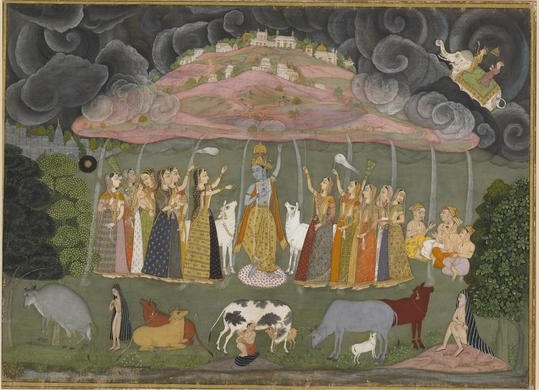
Indian monsoons always have always had their own story to narrate. This season has left its imprint in all types of literature, starting from ancient texts such as the Rigveda. The knowledge of monsoon winds and height of clouds along with the division of atmosphere was well developed in the Vedic age itself. Ancient Vedic literature even figuratively describes the evaporation–rainfall cycle and identifies the Sun as the cause of rainfall [2].
The journey in search of the monsoon started long ago. The Rigveda as well as Silappadhikaram narrate various forms of winds, clouds and rains, linking these natural phenomena to the cultural life of people [3]. The renowned Sanskrit poet, Kalidasa’s ‘Meghadūta’ stands testimony to how clouds were used to convey messages, where an exiled yakṣa (nature spirit) asked a cloud to carry a message to his beloved wife [3].
Photo: Rajput Painting on the Theme of Monsoon | Source: British Museum
The Nakshatra Based Rainfalls
Agricultural production in India mainly depends upon the monsoon rainfall. The Southwest monsoon is in full swing as it brings 75% of the rain to the country. These rains are critical to almost 60% of India’s rain-fed agriculture and the timely arrival and adequacy of monsoon winds plays a vital role in our farming practices. Its timely onset, spread over the country and distribution is important for seasonal crops. Farmers are more interested in the forecast of 3-4 days. India has an age old tradition of astronomical studies and treatises that predict rainfall in a region based on various parameters of astronomy. One of the traditional ways the farmers of India in general and its Southern States in particular study rainfall patterns is through solar constellations called “Nakshatras” [5]. The agricultural operations in the earlier years are mainly dependent on the seasons and Nakshatra period [5]. Nakshatras are 13 or 14 days periods which are also based on the solar calendar [5]. The nakshatra commences when the sun enters the specific constellation. The nakshatras stand for the twenty seven constellations through which the sun passes in a year. Hence the period of each nakshatra is about 14 days [5]. Nakshatra based rainfall periods have more influence on rice and wheat production of India [5].
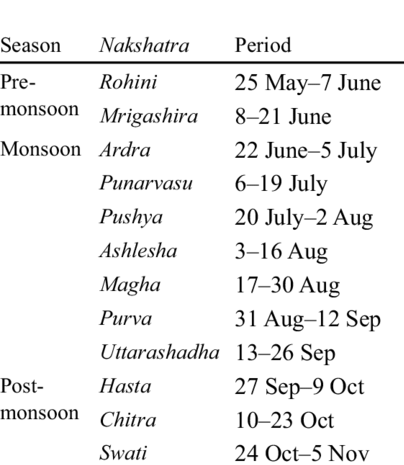
In the 27 constellations (or nakshatra) of Hindu astronomy there are 13 rain constellations in all; namely Kritika, Rohini, Mriga, Ardra, Punarvasu, Pushya, Ashlesha, Magha, Purva, Uttara, Hasta, Chitra, and Swati. There are peculiar rain patterns associated with each of these constellations. For example, Rohini is theorised to bring pre-monsoon showers, while Mriga is believed to bring the monsoon rains in full swing, both very important for farmers and agriculture [6]. The earth gets heated during summer and the pre-monsoon showers moisten and cool the soil [6]. Therefore, the farmers plough the fields after the pre-monsoon showers, and follow that with sowing when monsoon begins. Under Uttara, the rain is said to head north, therefore it rains less.
Shravana, the first month of the monsoon season gains much importance as it heralds the onset and is indicated by a three-star constellation (nakshatra) [7].
The hope for abundant rain, good crop, and lots of water has inspired many verses, and compositions [8]. Songs are written when there is rainfall during a particular nakshatra [8], and Indian poets have sung about the rainy season in prose and verse. During the mruga nakshatra, if the insect associated with this nakshatra enters the house, people apply kum-kum on it, pray and sing songs, as it is believed to be auspicious; a sign of promising monsoons, which make farmers happy and hopeful [8]. It also denotes the time when farmers need to start preparing for the sowing season [8].
Photo Source: Chinchorkar. S. S., Vaidya. V. B., Pandey. V., & Damle.K. S.. (January 2013). Nakshatra-wise Rainfall Variability at Anand in Middle Gujarat Region. Asian Agri-History. (PDF) Nakshatra-wise Rainfall Variability at Anand in Middle Gujarat Region (researchgate.net)
The 6 Rutus and the Rains
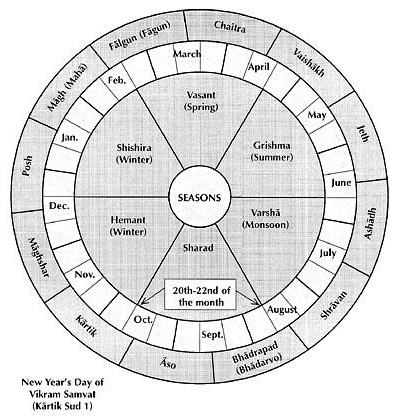
India is one of the few countries that face a lot of variations in terms of seasons. According to Indian tradition and ancient literature, a year is divided into six seasons that last for a couple of months each. [4]. Here are the six seasons as per the Hindu Calendar and how it relates to the calendar we use today:
Seasons – Months (According to the Indian Calendar) – & Months (According to the English Calendar)
- Vasanta – Chaitra-Vaisakha – March-April
- Grishma – Jyaistha-Asadha – May-June
- Varsha – Sravana-Bhadra – July-August
- Sharada – Asvina-Kartika – September-October
- Hemanta – Margashirsa-Pausa – November-December
- Shishira – Magha-Phalguna – January-February
This cycle of seasons, which the common people in north and central India follow is based on their practical experience and age-old perception of weather phenomena [4]. However, this system does not match with the seasons of south India where there is little variation in the seasons. [4]
Varsha Ritu , aka the monsoon season, is the time of year when it rains heavily across most of India. Many Indian festivals are celebrated during these months like Raksha Bandhan (A festival to celebrate the bond between brothers and sisters), Krishna Janmashtami (Sri Krishna’s birth anniversary), and Onam (A harvest festival). Varsha Ritu begins June 21, 2021 and ends on August 23, 2021.
Varsha Rutu is a generally viewed as an auspicious time, and gives the hope to abundance and prosperity.
Photo: The Hindu Calendar & Seasons | Source: BAPS Swaminarayan Sanstha
Understanding Monsoon Meteorology
The nature and mechanism of the monsoon are discussed here to understand what brings monsoon in our country, arrival of monsoon, branches of monsoon and how is there so much accuracy in the prediction of monsoon.
South West and North East Monsoons
Since India has a “Tropical Monsoon” type of climate, each monsoon brings torrential rains to the plains and mountains of the sub-continent. There are a few essential factors required to cause such monsoon rains. The most important is the unique geographical features that the subcontinent enjoys. First, the presence of abundant water bodies around the land mass, the Arabian Sea, the Indian Ocean and the Bay of Bengal, help in accumulating moisture in the winds during the summer [3]. Second, the presence of mountains or highlands like the Western Ghats and the Himalayas that lie across the path of the southwest monsoon winds [3]. When the winds hit these highlands, they are forced to rise causing orographic precipitation, that is precipitation that occurs when moist air is lifted over elevated terrain[3].
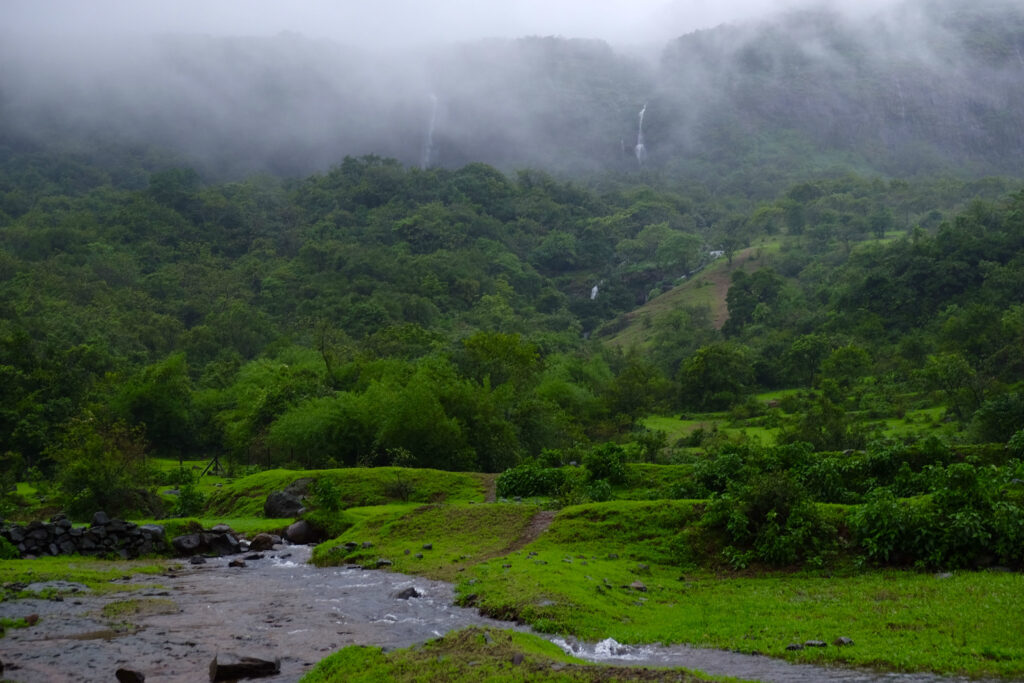
The Western Ghats are the first highlands that the South-West monsoon encounters. These Ghats rise very abruptly from the Western Coastal Plains thus making effective orographic barriers for the monsoon winds [3]. The Himalayas, on the other hand, are not only a great orographic barrier; but they also help confine the winds to the Indian subcontinent [3]. If these mountain ranges were not in place, the winds would blow right into China, Afghanistan and Russia without causing rain in the subcontinent [3]. Finally, the Eastern Ghats play the role of the orographic barrier for the northeast monsoon [3].
India’s climate is affected by two seasonal winds – the northeast monsoon wind and the southwest monsoon wind. According to the India Meteorological Department, they are the seasonal reversals of wind direction along the shores of the Indian Ocean, especially the Arabian Sea.
Photo: Rain in Tamhini Ghats & Mahabaleshwar, Maharashtra | Source: Times of India
The South-West monsoon wind blows from the Indian Ocean, towards the Indian sub-continent from June to September [3]. When these rain-bearing winds touch the southern-most tip of the Indian peninsula, they split into two branches – one the Arabian Sea branch and the Bay of Bengal branch [3]. Description: Seasonal difference of monsoon winds. Source: Pearson Prentice Hall, Inc. (2005) As October rolls in, these winds change direction and begin to blow in the north-eastern direction [3]. This is now a land to sea flow – where the wind heads down from the subcontinent to the Indian Ocean. At this point they carry less moisture and bring rain to only certain parts of the subcontinent — Andhra Pradesh and Tamil Nadu. [3] This is the North East monsoon and is responsible for maintaining the rice bowls of south India [3].
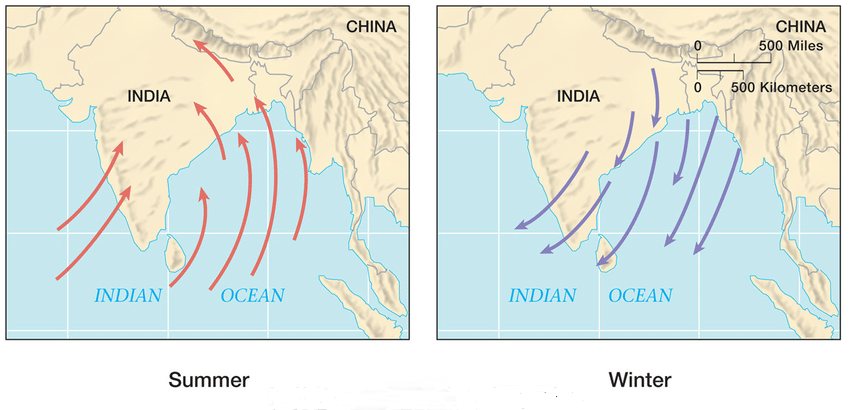
Photo: Seasonal difference of monsoon winds | Source: Pearson Prentice Hall, Inc. (2005)
Arrival of Monsoon
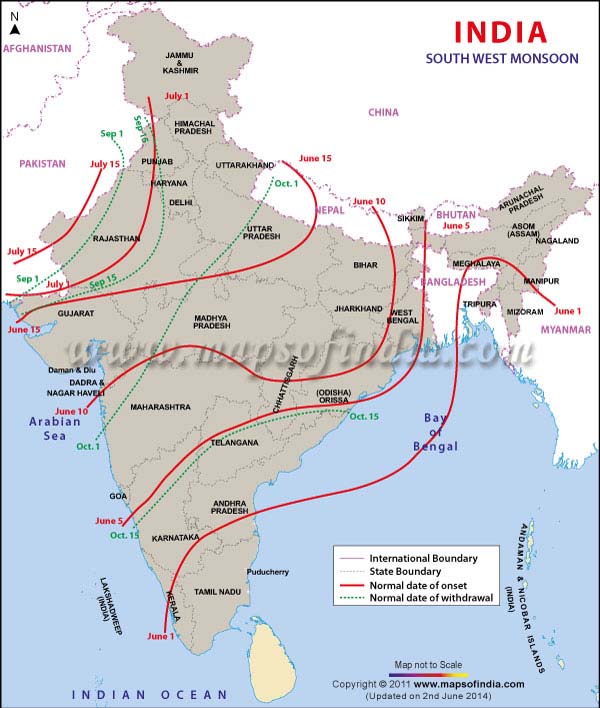
Towards the end of the nineteenth century, it was believed that the differential heating of land and sea during the summer months is the mechanism which sets the stage for the monsoon winds to drift towards the subcontinent. Monsoon in India usually starts from June and lasts till Mid-September. As explained above, this is called the “South West Monsoon”, and its advancement over the Indian mainland is marked by the onset of monsoons over the coast of Kerala by 1st June, following which is moves swiftly to reach Mumbai and Kolkata between 10th and 13th June. Since the south-west monsoon splits into two branches as it reaches the southernmost tip of the Indian Peninsula, the reception of these winds is different in each place.
The Bay of Bengal Branch:
The Arakan Hills along the coast of Myanmar deflect a big portion of the Bay of Bengal monsoon branch towards the Indian subcontinent so the branch enters West Bengal and Bangladesh from south and southeast instead of from the south-westerly direction [9]. From here, this branch splits into two under the influence of the Himalayas and the thermal low is northwest India. One branch moves westward along the Ganga plains reaching as far as the Punjab plains [9]. The other branch moves up the Brahmaputra valley in the north and the northeast, causing widespread rains. Another sub-branch strikes the Garo and Khasi hills of Meghalaya [9]. Mawsynram, located on the crest of Khasi hills, receives the highest average annual rainfall in the world. The North-East region comprising Assam, Arunachal Pradesh, Manipur, Meghalaya, Mizoram, Nagaland, Sikkim, and Tripura receives heavy to very heavy rainfall during the South-West Monsoon season (June to September), and rains peak in June. By mid-July, southwest monsoon engulfs the entire subcontinent [9].
Photo: South West Monsoon Map | India map, Ancient india map, India world map | Source: MapsOfIndia.com
During October and November, northeast monsoon while crossing over the Bay of Bengal, picks up moisture and causes torrential rainfall over the Tamil Nadu coast, southern Andhra Pradesh, southeast Karnataka and southeast Kerala.
The Arabian Sea branch:
This branch of the southwest monsoon brings orographic rain to the west coast of India due to the obstruction by the Western Ghats [9]. Soon, the winds become cool, resulting in the windward side of the Sahyadris and Western Coastal Plain receiving very heavy rainfall [9]. After crossing the Western Ghats, these winds descend and get heated up, therefore reducing the humidity in the winds [9]. As a result, these winds cause little rainfall east of the Western Ghats [9]. This region of low rainfall is known as the rain-shadow area [9].
Measuring & Forecasting of Monsoons
India has a predominantly rain nurtured Agriculture, due to which, it is solely dependent on rainfall. A weak monsoon year with low rainfall can cause a low crop yield. On the other hand, a strong monsoon is favourable for abundant crop yield, and excessive rainfall may cause devastating floods. So monsoon rainfall prediction, forecasting of monsoon onset and defining monsoon withdrawal, monitoring monsoon is of utmost importance to the environment as well as economy.
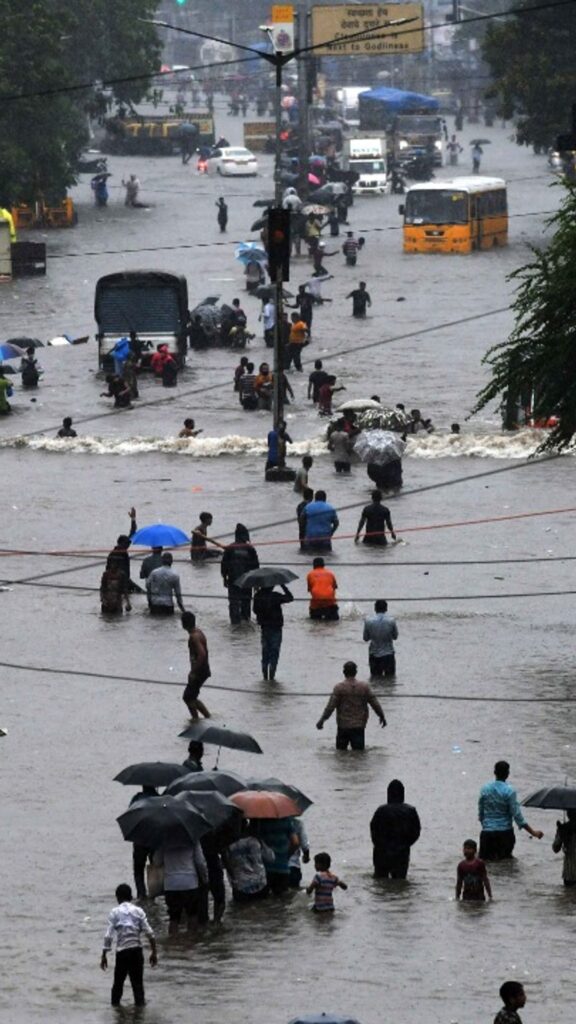
Measuring and forecasting of the monsoon is a regular activity for the Indian Meteorological Department (IMD) – the Indian government’s principal agency for weather forecasting and rainfall monitoring.
IMD brands the monsoon as ‘normal’ or ‘deficient’ based on how it fares against its benchmark Long Period Average (LPA). LPA is the average rainfall received by the country as a whole during the south-west monsoon, for a 50-year period. The LPA is the average rainfall recorded during 1961 to 2010 which currently measures at 88cm. IMD considers rainfall between 96% to 104% of LPA to be in “normal” range.
For monsoon forecasting, the IMD relies on an ensemble model, a statistical technique that uses an average of six meteorological values correlated to the monsoon. Along with the traditional method, IMD also uses supercomputer simulation-driven methods [10]. These dynamical models simulate the state of the atmosphere and oceans at a particular time and then extrapolate those into the future using standard laws of physics [10].
The prediction of monsoon is done by IMD in different spatial and temporal scales [11]. It varies from the country as a whole, to district-wise predictions which are done in spatial scales, and from a seasonal forecast to nowcast (a weather forecast in which the details about the current weather and forecasts up to a few hours ahead but less than 24 hours are given) which are conducted in temporal scale [11].
Seasonal forecast for monsoon rainfall is issued based on long range forecast (LRF) in the month of April for the entire country [11]. This forecast update in the month of May for the entire country and also for its broad homogenous regions [11]. LRF of monsoon will give a general picture of seasonal and monthly rainfall for the coming monsoon season [11]. Extended range forecast of IMD issued in every Thursday of the week give forecast for a period extending from about 10days to 30 days in advance for the entire country [11]. This helps in the forecasting of active-break cycle of monsoon, formation of monsoon lows and depressions [11].
Real time monitoring of the monsoon is done by IMD using remote sensing techniques like satellite and Radars.
Information on monsoon is readily available and updated daily on IMD’s website: https://mausam.imd.gov.in .For details on forecasting methods of IMD check out here at monsoonfaq.pdf (imd.gov.in)
Photo Source: The Weather Channel (TWC)
Edited By: Aalisha Jadhav
Source:
- Kurian, N. (2012, July 16). Here Comes the Rain!, The Hindu, , Retrieved from https://www.thehindu.com/features/kids/here-comes-the-rain/article3645097.ece
- Iyengar. R.N., Monsoon rainfall Cycles As Depicted in Ancient Sanskrit Texts, Retrieved from https://www.researchgate.net/publication/237247119_Monsoon_rainfall_cycles_as_depicted_in_ancient_Sanskrit_texts
- Saju, M.T. (2018, June 3). Monsoon Puzzled Man in Vedic Times Too, Times of India, Retrieved from https://timesofindia.indiatimes.com/blogs/tracking-indian-communities/monsoon-puzzled-man-in-vedic-times-too/?source=app&frmapp=yes
- Geography, Central Institute of Educational Technilogy, Digital India https://ciet.nic.in/moocspdf/Geography%2002/kegy_20404_e-text.pdf
- Subash. N., Singh. S. S. & Priya. N., Nakshatra Based Rainfall Variability, Trends and Its Influence on Rice-Wheat Production – A case study over two sites in Bihar, India. Journal of Agrometeorology 13 (1): 31-37 (June 2011),
- Retrieved from http://agrimetassociation.org/journal/fullpage/fullpage-20200125961255998.pdf
- The farmer and The Rain Song – People’s Archive of Rural India, Retrieved from https://ruralindiaonline.org/en/articles/the-farmer-and-the-rain-song/
- Jafa, N. (2018, July 13). The Meaning of Monsoon Clouds, The Hindu, Retrieved from https://www.thehindu.com/society/history-and-culture/the-meaning-of-monsoon-clouds/article24410293.ece
- Chandanshive, G., Monsoon Music: Maharashtra Sings of Farmers and Fruitful Harvests, Retrieved from https://www.firstpost.com/long-reads/monsoon-music-maharashtra-sings-of-farmers-and-fruitful-harvests-5300401.html
- CLIMATE, VEGETATION AND SOIL, National Council of Educational Research and Training (NCERT), Retrieved from https://ncert.nic.in/ncerts/l/kegy104.pdf
- Sreevatsan, A. (2018, 2 August). The Art of Monsoon Forecasting in India, and the Science Behind It, Livemint, Hindustan Times. Retrieved from https://www.livemint.com/Politics/Z10z9lZHnne1RgoRtVvUEK/The-art-of-monsoon-forecasting-in-India-and-the-science-beh.html
- Frequently asked Questions (FAQs) on Monsoon, Indian Meteorological Department (IMD), Retrieved from https://mausam.imd.gov.in/imd_latest/monsoonfaq.pdf
- A Guide to the 6 Seasons of the Hindi Calendar, Subhamoy Das. https://www.learnreligions.com/the-six-seasons-of-india-p2-1770072


